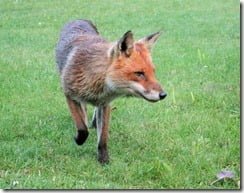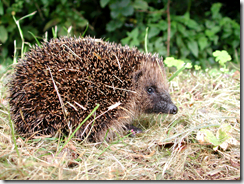 The red fox is common throughout Ireland in both rural and urban habitats. Elusive, and largely nocturnal, the fox usually stays well hidden and many people, particularly in our cities, go about their lives completely oblivious to the proximity of this striking mammal.
The red fox is common throughout Ireland in both rural and urban habitats. Elusive, and largely nocturnal, the fox usually stays well hidden and many people, particularly in our cities, go about their lives completely oblivious to the proximity of this striking mammal.
Adult foxes grow to around a metre (3.28 foot) in length and weigh between five and seven kilos (11-15.5 lb), with the dog fox being slightly larger and heavier than the vixen. In captivity foxes can live for up to fourteen years, but the average lifespan of wild adults is much less. The breeding season starts in December and peaks around the end of January and start of February. During this period foxes are more active during the day than normal and are generally seen more frequently by people.
The fox’s earth can be found in a variety of habitats, but a favourite rural location is at the periphery of woodland where there is plenty of cover and easy access to both the wood and to the open pastures beyond. Occasionally foxes will occupy old rabbit warrens or badger sets to rear their young.
On average four to five cubs are born around March onto the bare soil of an underground chamber down in the earth. The young are born blind and covered in short chocolate-coloured fur. Their eyes open at around two to three weeks old, and at first are a slate-blue colour, changing to brown or amber at about four to five weeks. This coincides with the start of a change in coat colour, the chocolate brown gradually changing to the more familiar red — although individuals can vary greatly in colour, with some remaining quite dark for life. By this time the inquisitive cubs have started to explore outside the earth, first on wobbly legs, but becoming increasingly steady and bold as the weeks draw on. They begin foraging for food around the entrance of the earth and will take the odd beetle, earthworm or slug if the opportunity presents itself.
Although foxes have no natural predators many die young through a combination of disease, shootings, fox-hunting and other factors. A particularly big killer is traffic, and large numbers of foxes die every year on our roads. Death rates are particularly high during the breeding season, when foxes wander more widely and are generally more active, exposing themselves to more risks. Another period of high mortality is during April and May when the adults are struggling to feed a hungry litter of cubs, the increased activity again exposing the adults to more danger.
Despite high mortality rates the fox remains an incredibly successful animal, and is one of the opportunist champions of the animal kingdom. Foxes thrive in urban environments the world over, and take full advantage of our wasteful existence to eke out a very satisfactory living in our cities. Urban fox populations are often denser and more prolific than their rural counterparts, thanks largely to a surfeit of food available in urban surroundings. Scavenging is much easier than hunting for a living and urban foxes are extremely successful scavengers.
In rural communities foxes often get a bad name for attacking livestock, and while it is true that a fox will feed on a dead sheep, or will carry away a dead lamb if it comes across one, there are few substantiated claims of foxes taking healthy livestock. On the Isle of Mull in Scotland, where there are no foxes, records show that rates of lamb survival are no higher than those of the mainland, where foxes are common. Similarly the fox that takes chickens or ducks is only acting on a predators instinct to avail of the most easily available food source.
Tales of the fox as a ruthless killer that slaughters for enjoyment are also greatly exaggerated. Any predator, when confronted with an abundance of prey animals (such as a fox will encounter in the chicken coop) will instinctively kill multiple animals, and, if left undisturbed, will then return to recover each of them and will cache them for retrieval in harder times ahead. When the fox is disturbed it makes a swift exit, leaving several dead birds behind it, and earning its unjustified reputation as a wasteful killer.
Ultimately the foxes are doing what comes naturally to any predator, and it is up to people to protect their poultry in secure accommodation at night when foxes are abroad. Predators like foxes play a vital role in healthy natural ecosystems, and despite a high mortality rate and often unjustified persecution, these adaptable mammals continue to thrive.










1 comment